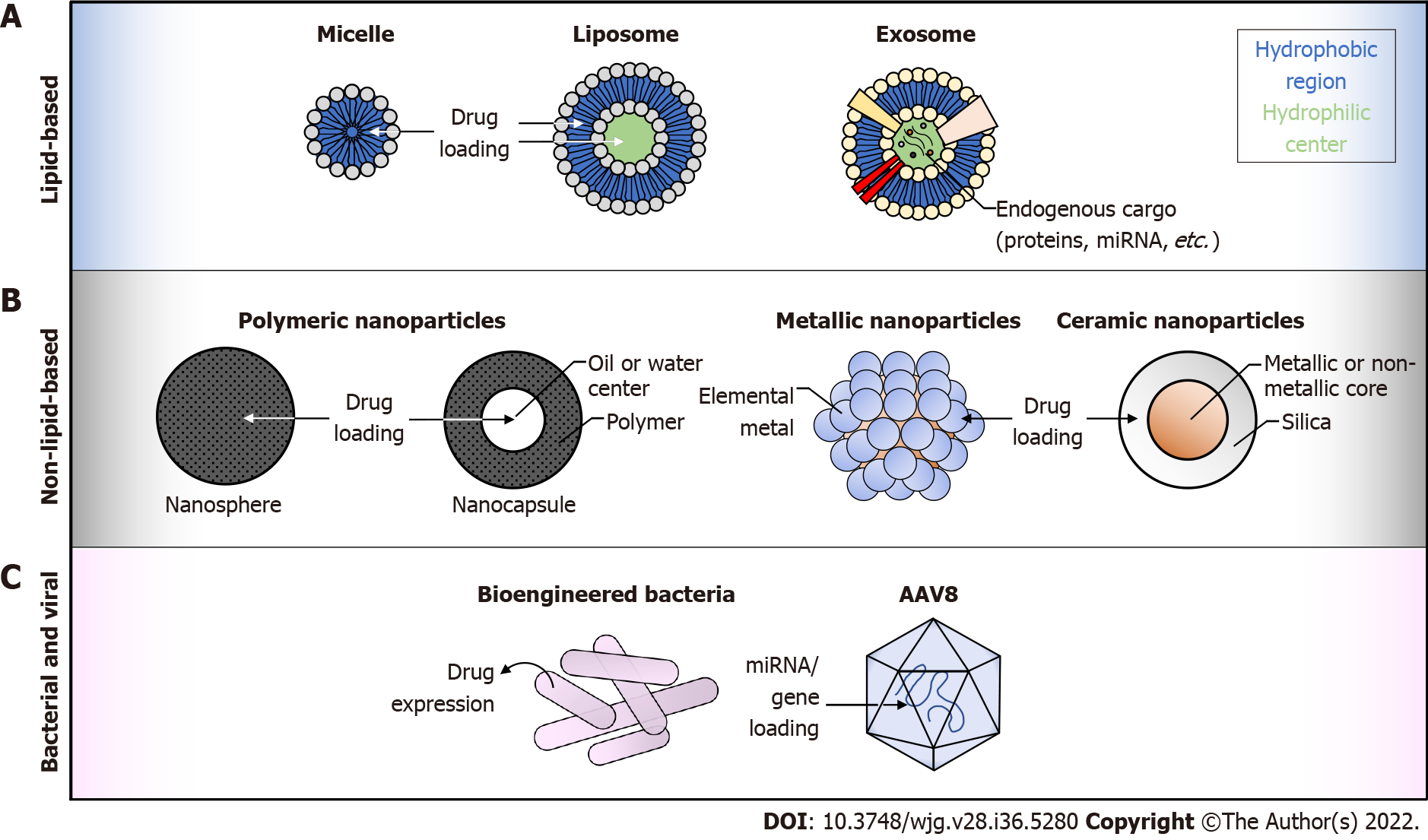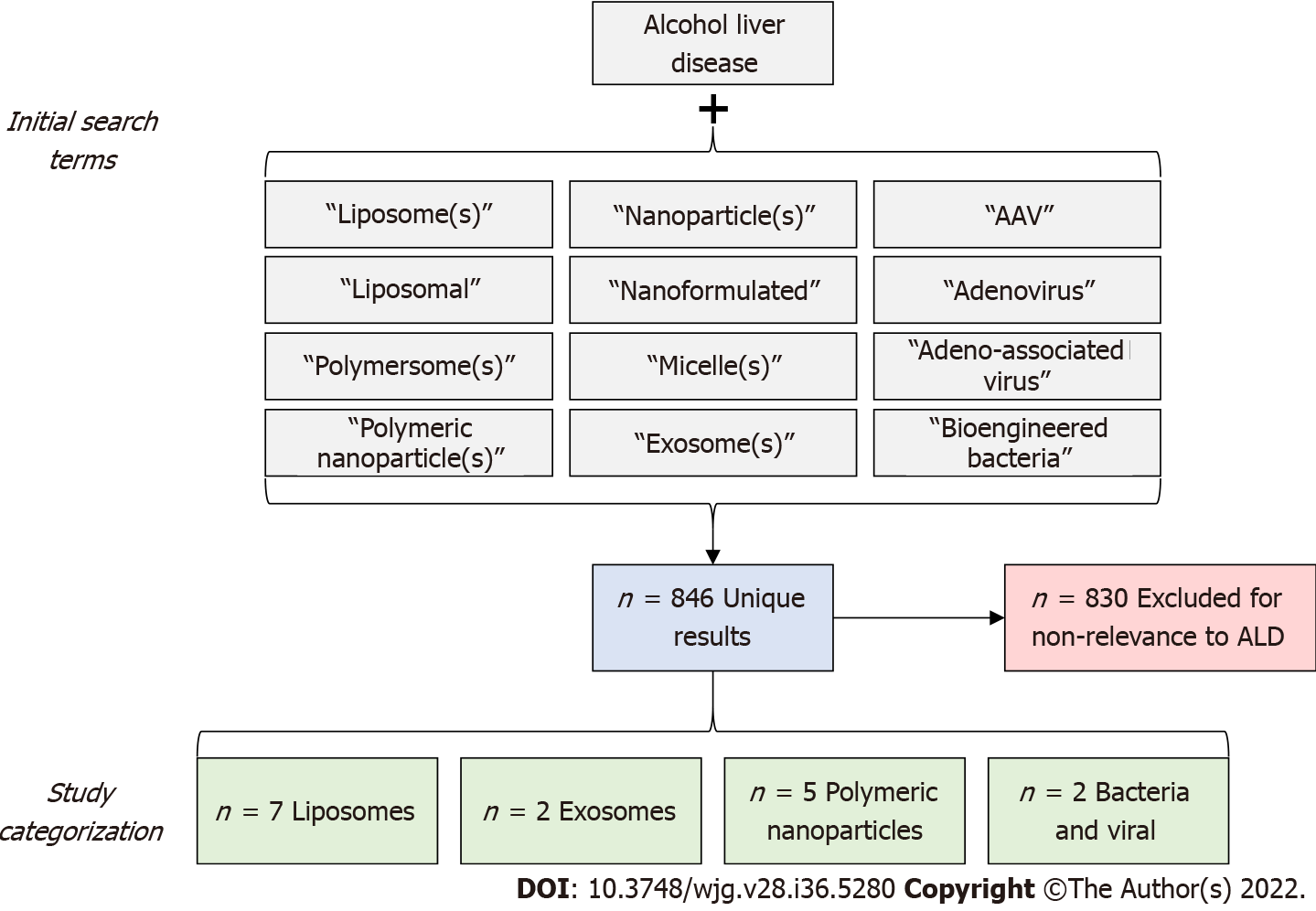Copyright
©The Author(s) 2022.
World J Gastroenterol. Sep 28, 2022; 28(36): 5280-5299
Published online Sep 28, 2022. doi: 10.3748/wjg.v28.i36.5280
Published online Sep 28, 2022. doi: 10.3748/wjg.v28.i36.5280
Figure 1 Spectrum and pathophysiology of alcohol-associated liver disease.
A: Schematic diagram describing the spectrum of disease stages in alcohol-associated liver disease (ALD). Percentages represent proportion of chronic drinkers who progress to the indicated disease stage; B: Schematic diagram depicting the pathophysiology of ALD. Ethanol affects both the gut and liver to induce changes in lipid metabolism, generation of reactive oxygen species and hepatocyte cell death, gut permeability, and downstream consequences including inflammation, hepatic stellate cell activation, fibrosis, DNA damage, and carcinogenesis. ALD: Alcohol-associated liver disease; ROS: Reactive oxygen species; HSC: Hepatic stellate cell.
Figure 2 Graphical representation of targeted drug delivery platforms.
A: Lipid-based particles, including micelles, liposomes, and exosomes; B: Non-lipid-based particles, including polymeric nanospheres and nanocapsules, metallic nanoparticles, and ceramic nanoparticles; C: Bioengineered bacteria and adeno-associated virus serotype 8. Graphics are not drawn to scale. miRNA: MicroRNA; AAV8: Adeno-associated virus serotype 8.
Figure 3 Lobular liver architecture and biodistribution of nanoparticles.
A: Top-down view of a liver lobule. Portal triads, consisting of a portal vein, hepatic artery, and bile duct, surround a central vein in a hexagonal shape. Concentric hexagons designate zones 1-3 moving from the outside to the inside. Portal and arterial blood flows from the triads toward the central vein, whereas bile travels the opposite direction; B: Side view. With the portal triad on the left, portal blood brings nanoparticles from the digestive tract to the liver sinusoids where they can interact with Kupffer cells, liver sinusoidal endothelial cells, and others. Nanoparticles of sufficiently small size can pass through the liver fenestrae formed by liver sinusoidal endothelial cells to access the Space of Disse, and subsequently, hepatocytes. Images are not drawn to scale.
Figure 4 Schematic representation of literature search strategy.
Initial search terms included “alcohol liver disease” combined with the boxed terms. Eight hundred and forty-six unique results were generated, screened by title and abstract, and excluded based on relevance to the scope of the review. Sixteen studies were included in the review, broken down into four categories based on drug delivery platform. ALD: Alcohol-associated liver disease; AAV: Adeno-associated virus.
Figure 5 Summary of studies applying nanoparticle platforms in alcohol-associated liver disease.
A graphical summary of nanoparticle platforms which to date have been applied for the treatment or prevention of alcohol-associated liver disease in rodent models. Arrows represent organ targets of each platform. Example cargoes used in research articles discussed in this review are listed next to each platform. Current limitations of the field are described on the lower right. AAV8: Adeno-associated virus serotype 8; HSCs: Hepatic stellate cells; IL-22: Interleukin 22; KCs: Kupffer cells; miRNA: Micro-RNA; PCX: Polycationic CXCR4 antagonists; S-ODN: Antisense phosphorothioate oligodeoxynucleotide.
- Citation: Warner JB, Guenthner SC, Hardesty JE, McClain CJ, Warner DR, Kirpich IA. Liver-specific drug delivery platforms: Applications for the treatment of alcohol-associated liver disease. World J Gastroenterol 2022; 28(36): 5280-5299
- URL: https://www.wjgnet.com/1007-9327/full/v28/i36/5280.htm
- DOI: https://dx.doi.org/10.3748/wjg.v28.i36.5280













